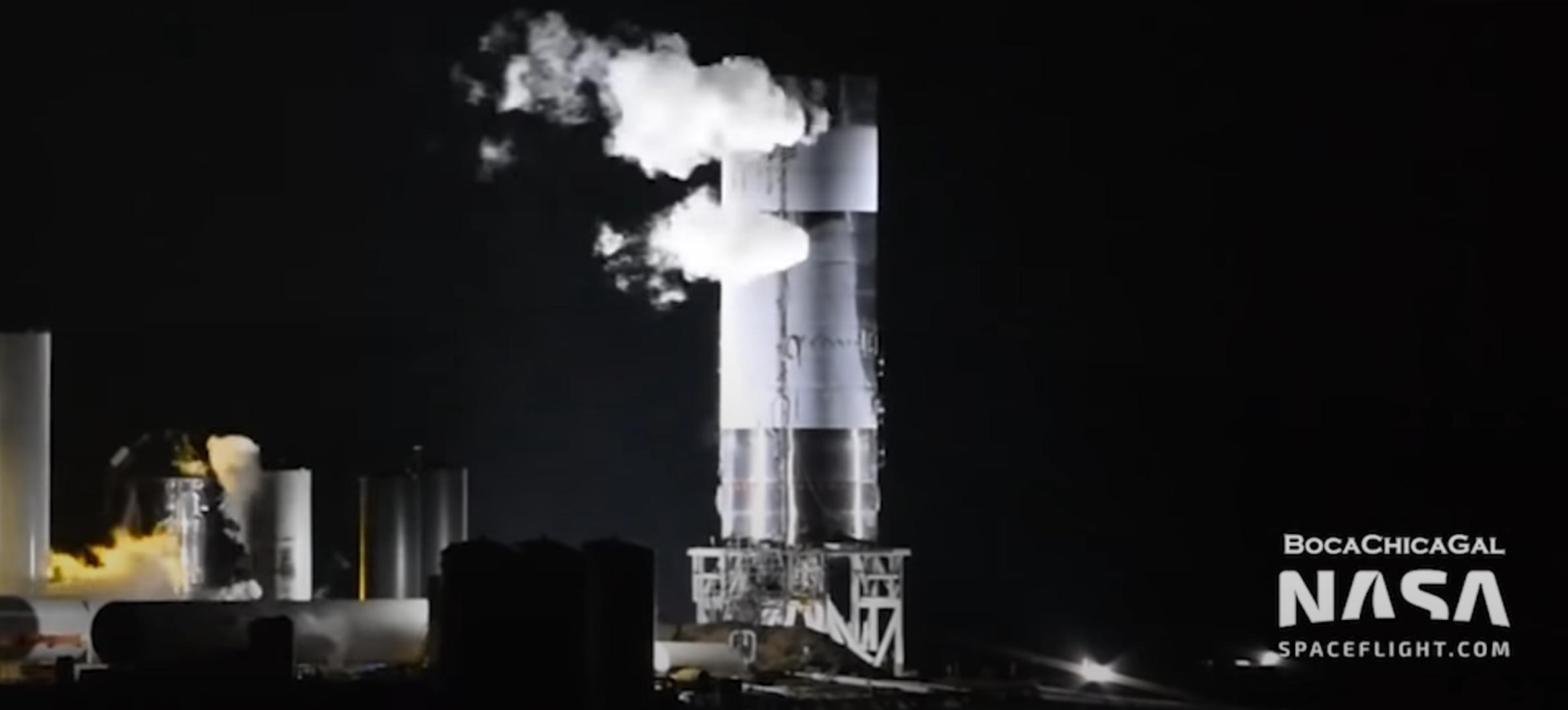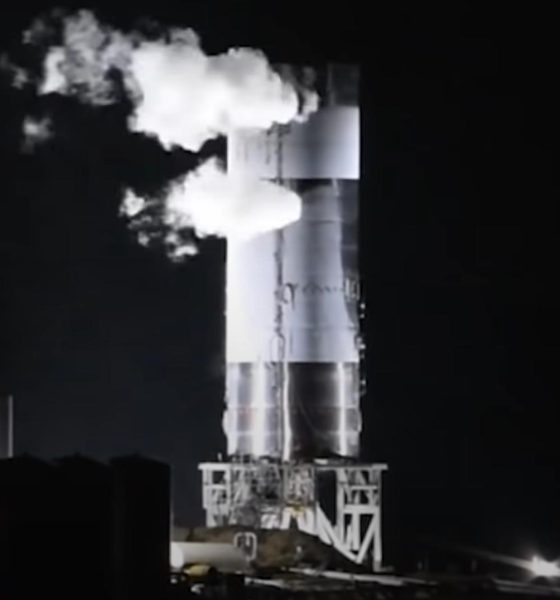

News
SpaceX Starship passed “cryo proof” test for the first time and here’s what’s next
Elon Musk says a SpaceX Starship prototype has passed a critical “cryo proof” test for the first time, opening the door for the rocket to move on to even bigger tests.
Late on April 26th, SpaceX’s South Texas team (and possibly a console team in California) readied the fourth full-scale Starship prototype (SN4) for its second major test. Known as a cryogenic proof test, it began less than 24 hours after the rocket completed a room-temperature gas pressure test to check for leaks and verify that the pressure vessel was sound. Musk quickly confirmed that Starship SN4 passed through that “ambient proof test” without issue.
For the cryo proof test, room-temperature nitrogen gas was replaced with ultra-cold liquid nitrogen, serving as a chemically neutral (i.e. non-explosive) simulant for Starship’s liquid oxygen and methane propellant. After a few hours of partial loading and offloading cycles meant to ensure that Starship’s valves and propellant supply hardware was working as intended, SpaceX controllers fully filled the rocket with some ~1000 metric tons (2.2 million lb) of liquid nitrogen. Once full, a hydraulic ram setup was activated to exert forces akin to Raptor engines operating at full thrust. After several prior failures, Starship SN4 thus became the first to survive the ordeal and graduate into the next stage of testing.
According to CEO Elon Musk, that next step will be a static fire test with a lone Raptor engine installed. Able to produce at least 200 metric tons of thrust (~450,000 lbf) at full throttle, Raptor is an exceptionally efficient methalox (methane/oxygen) rocket engine designed by SpaceX to power Starship and its Super Heavy booster. Methane and oxygen was chosen in large part because of the relative potential ease of its extraction and refinement on Mars.
Per Musk, that static fire could occur within the next six or so days, meaning that SpaceX will likely install a functional Raptor engine on a full-scale Starship for the first time ever within the next day or two. Before a static fire can be performed, though, another significant test or two will have to be completed.
Known as a wet dress rehearsal (WDR), the first of those tests will be similar to April 26th’s cryo proof but with the neutral liquid nitrogen placed by real liquid oxygen and methane propellant. This is much riskier than the cryo proof in the sense that if a tank failure were to occur or a fire to accidentally start, 1000+ tons of highly-pressurized propellant could easily create a massive explosion and fireball, destroying or damaging much of the surrounding pad equipment. The WDR could potentially be rolled into another Raptor engine test that would verify its preburner performance.


To operate, Raptors first take liquid oxygen and liquid methane into separate parts of the engine and rapidly heat them to turn them into high temperature gas. Those preburners then send that hot gas to separate turbopumps that spin up and allow the engines to keep supplying themselves with large quantities of propellant, followed by the process of actually igniting the engine itself with a complex series of blowtorches.
If the preburner and turbopump spin-up test is successful, SpaceX can then move on to the actual static fire. Featuring a single Raptor engine, Starship SN4 will hopefully become the first full-scale rocket to safely operate a flight-grade engine since SpaceX began full-scale tests in November 2019. If successful, that static fire could pave the way for Starship SN4 to perform a Starhopper-style 150m (500 ft) hop test as early as May 2020 – a hop that would be powered by a single Raptor engine according to Musk.
Starship SN5 will reportedly be the first ship to both have a nosecone installed and three Raptor engines installed if SN4 has a very successful few weeks and that new ship is perhaps just 5-10 days from being fully assembled. In short, things are about to get very busy and very exciting at SpaceX’s South Texas Starship factory and launch pad.

News
Tesla China delivery centers look packed as 2025 comes to a close
Needless to say, it appears that Tesla China seems intent on ending 2025 on a strong note.

Tesla’s delivery centers in China seem to be absolutely packed as the final days of 2025 wind down, with photos on social media showing delivery locations being filled wall-to-wall with vehicles waiting for their new owners.
Needless to say, it appears that Tesla China seems intent on ending 2025 on a strong note.
Full delivery center hints at year-end demand surge
A recent image from a Chinese delivery center posted by industry watcher @Tslachan on X revealed rows upon rows of freshly prepared Model Y and Model 3 units, some of which were adorned with red bows and teddy bears. Some customers also seem to be looking over their vehicles with Tesla delivery staff.
The images hint at a strong year-end push to clear inventory and deliver as many vehicles as possible. Interestingly enough, several Model Y L vehicles could be seen in the photos, hinting at the demand for the extended wheelbase-six seat variant of the best-selling all-electric crossover.
Strong demand in China
Consumer demand for the Model Y and Model 3 in China seems to be quite notable. This could be inferred from the estimated delivery dates for the Model 3 and Model Y, which have been extended to February 2026 for several variants. Apart from this, the Model Y and Model 3 also continue to rank well in China’s premium EV segment.
From January to November alone, the Model Y took China’s number one spot in the RMB 200,000-RMB 300,000 segment for electric vehicles, selling 359,463 units. The Model 3 sedan took third place, selling 172,392. This is quite impressive considering that both the Model Y and Model 3 are still priced at a premium compared to some of their rivals, such as the Xiaomi SU7 and YU7.
With delivery centers in December being quite busy, it does seem like Tesla China will end the year on a strong note once more.
News
Tesla Giga Berlin draws “red line” over IG Metall union’s 35-hour week demands
Factory manager André Thierig has drawn a “red line” against reducing Giga Berlin’s workweek to 35 hours, while highlighting that Tesla has actually increased its workers’ salaries more substantially than other carmakers in the country.

Tesla Giga Berlin has found itself in a new labor dispute in Germany, where union IG Metall is pushing for adoption of a collective agreement to boost wages and implement changes, such as a 35-hour workweek.
In a comment, Giga Berlin manager André Thierig drew a “red line” against reducing Giga Berlin’s workweek to 35 hours, while highlighting that Tesla has actually increased its workers’ salaries more substantially than other carmakers in the country.
Tesla factory manager’s “red line”
Tesla Germany is expected to hold a works council election in 2026, which André Thierig considers very important. As per the Giga Berlin plant manager, Giga Berlin’s plant expansion plans might be put on hold if the election favors the union. He also spoke against some of the changes that IG Metall is seeking to implement in the factory, like a 35-hour week, as noted in an rbb24 report.
“The discussion about a 35-hour week is a red line for me. We will not cross it,” Theirig said.
“(The election) will determine whether we can continue our successful path in the future in an independent, flexible, and unbureaucratic manner. Personally, I cannot imagine that the decision-makers in the USA will continue to push ahead with the factory expansion if the election results favor IG Metall.”
Giga Berlin’s wage increase
IG Metall district manager Jan Otto told the German news agency DPA that without a collective agreement, Tesla’s wages remain significantly below levels at other German car factories. He noted the company excuses this by referencing its lowest pay grade, but added: “The two lowest pay grades are not even used in car factories.”
In response, Tesla noted that it has raised the wages of Gigafactory Berlin’s workers more than their German competitors. Thierig noted that with a collective agreement, Giga Berlin’s workers would have seen a 2% wage increase this year. But thanks to Tesla not being unionized, Gigafactory Berlin workers were able to receive a 4% increase, as noted in a CarUp report.
“There was a wage increase of 2% this year in the current collective agreement. Because we are in a different economic situation than the industry as a whole, we were able to double the wages – by 4%. Since production started, this corresponds to a wage increase of more than 25% in less than four years,” Thierig stated.
News
Tesla is seeing a lot of momentum from young Koreans in their 20s-30s: report
From January to November, young buyers purchased over 21,000 Teslas, putting it far ahead of fellow imported rivals like BMW and Mercedes-Benz.

Tesla has captured the hearts of South Korea’s 20s-30s demographic, emerging as the group’s top-selling imported car brand in 2025. From January to November, young buyers purchased over 21,000 Teslas, putting it far ahead of fellow imported rivals like BMW and Mercedes-Benz.
Industry experts cited by The Economist attributed this “Tesla frenzy” to fandom culture, where buyers prioritize the brand over traditional car attributes, similar to snapping up the latest iPhone.
Model Y dominates among young buyers
Data from the Korea Imported Automobile Association showed that Tesla sold 21,757 vehicles to the 20s-30s demographic through November, compared to BMW’s 13,666 and Mercedes-Benz’s 6,983. The Model Y led the list overwhelmingly, with variants like the standard and Long Range models topping purchases for both young men and women.
Young men bought around 16,000 Teslas, mostly Model Y (over 15,000 units), followed by Model 3. Young women followed a similar pattern, favoring Model Y (3,888 units) and Model 3 (1,083 units). The Cybertruck saw minimal sales in this group.
The Model Y’s appeal lies in its family-friendly SUV design, 400-500 km range, quick acceleration, and spacious cargo, which is ideal for commuting and leisure. The Model 3, on the other hand, serves as an accessible entry point with lower pricing, which is valuable considering the country’s EV subsidies.
The Tesla boom
Experts described Tesla’s popularity as “fandom culture,” where young buyers embrace the brand despite criticisms from skeptics. Professor Lee Ho-geun called Tesla a “typical early adopter brand,” comparing purchases to iPhones.
Professor Kim Pil-soo noted that young people view Tesla more as a gadget than a car, and they are likely drawn by marketing, subsidies, and perceived value. They also tend to overlook news of numerous recalls, which are mostly over-the-air software updates, and controversies tied to the company.
Tesla’s position as Korea’s top import for 2025 seems secured. As noted by the publication, Tesla’s December sales figures have not been reported yet, but market analysts have suggested that Tesla has all but secured the top spot among the country’s imported cars this year.








